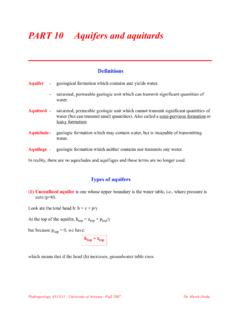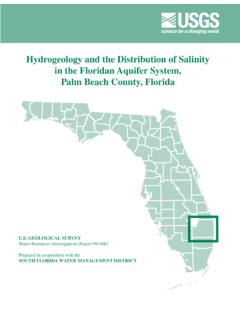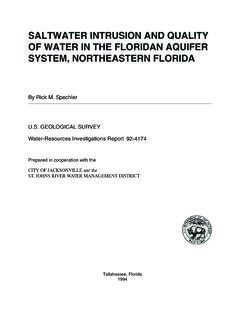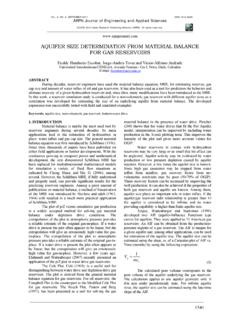Transcription of Thirstin Builds an Aquifer
1 Thirstin Buildsan AquiferK- 3 Aquifer IN A CUP ( Aquifer ON THE GO)BACKGROUND:Many communities obtain their drinking water from underground sources called aquifers. Water suppliers orutility officials drill wells through soil and rock into aquifers for the ground water contained therein to supplythe public with drinking water. Home owners who cannot obtain their drinking water from a public water sup-ply, will have their own private wells drilled on their property to tap this supply. Unfortunately, the groundwater can become contaminated by harmful chemicals such as lawn care products and household cleaners thatwere used or disposed of improperly after use or any number of other pollutants. These chemicals can enterthe soil and rock, polluting the Aquifer and eventually the well. Such contamination can pose a significantthreat to human health.
2 The measures that must be taken by well owners and water plant operators to eitherprotect or clean up contaminated aquifers are quite :This demonstration should follow a class discussion on potential sources of pollution todrinking water :To illustrate how water is stored in an Aquifer , how groundwater can become contaminated, and how this con-tamination ends up in a drinking water source. Ultimately, students should get a clear understanding of howcareless use and disposal of harmful contaminants above the ground can potentially end up in the drinkingwater below the ground. This particular experiment can be done by each student at their work station. MATERIALS NEEDED PER STUDENT:4 1 clear plastic cupthat is 2 3/4" deep x 3 1/4" wide for each student41 piece of modeling clay or floral claythat will allow a 2" flat pancake to be made by each student for their cup4 White play sandthat will measure 1/4" in bottom of each student's cup4 Aquarium gravel(natural color if possible) or small pebbles (approximately 1/2 cup per student) (HINT: As many small rocks may have a powdery residue on them, you may wish to rinse them and dry on a clean towel prior to use.)
3 It is best if they do not add cloudiness to water.)4 Red food coloring41 bucket of clean waterand small cupto dip water from bucket Office of Water (4606M) EPA 816-F-04-019 06/2004 :1. Pour 1/4" of white sand in the bottom of each cup completely covering the bottom of the container. Pourwater into the sand, wetting it completely ( there should be no standing water on top of sand). Let studentssee how the water is absorbed in the sand, but remains around the sand particles as it is stored in the groundand ultimately forming part of the Have each student flatten the modeling clay (like a pancake) and cover 1/2 of the sand with the clay (haveeach student press the clay to one side of the container to seal off that side). The clay represents a confininglayer that keeps water from passing through it. Pour a small amount of water onto the clay.
4 Let the studentssee how the water remains on top of the clay, only flowing into the sand below in areas not covered by the Use the aquarium rocks to form the next layer of earth. Place the rocks over the sand and clay, covering theentire container. To one side of your cup, have students slope the rocks, forming a high hill and a valley (seeillustration below). Explain to students that these layers represent some of the many layers contained in theearth's surface. Now pour water into your Aquifer until the water in the valley is even with your hill. Studentswill see the water stored around the rocks. Explain that these rocks are porous, allowing storage of waterwithin the pours and openings between them. They will also notice a surface supply of water (a small lake)has formed. This will give them a view of both the ground and surface water supplies which can be used fordrinking water Use the food coloring and put a few drops on top of the rock hill as close to the inside wall of the cup aspossible.
5 Explain to students that often old wells are used to dispose of farm chemicals, trash and usedmotor oils and other activities above their Aquifer can end up in their drinking water. They will see that thecolor spreads not only through the rocks, but also to the surface water and into the white sand at the bottomof their cup. This is one way pollution can spread throughout the Aquifer over time. FOLLOW-UP:Discuss with students other activities thatcould pollute their Aquifer . Assign studentsthe task of locating activities around theschool or their own homes that could pollutetheir drinking water sources if not properlymaintained. Allow students to drain off thewater in their cups and carry home their con-tainer to refill with water and show their par-ents surface and ground water and how thefood coloring illustrates pollution activityabove their Aquifer can affect all should discuss with parents whatsteps they can take as a household to preventwater :A: Rocks C:ClayB: Water D: Sand



















